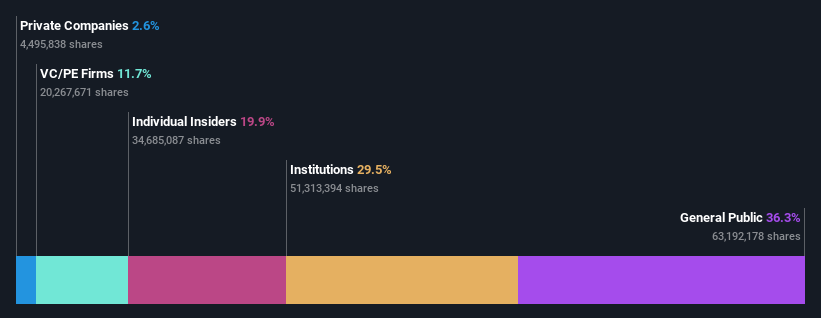- United States
- /
- Specialty Stores
- /
- NYSE:BARK
While institutions invested in BARK, Inc. (NYSE:BARK) benefited from last week's 33% gain, individual investors stood to gain the most

Key Insights
- The considerable ownership by individual investors in BARK indicates that they collectively have a greater say in management and business strategy
- 50% of the business is held by the top 9 shareholders
- Insiders have been selling lately
A look at the shareholders of BARK, Inc. (NYSE:BARK) can tell us which group is most powerful. We can see that individual investors own the lion's share in the company with 36% ownership. In other words, the group stands to gain the most (or lose the most) from their investment into the company.
Following a 33% increase in the stock price last week, individual investors profited the most, but institutions who own 29% stock also stood to gain from the increase.
Let's take a closer look to see what the different types of shareholders can tell us about BARK.
Check out our latest analysis for BARK

What Does The Institutional Ownership Tell Us About BARK?
Institutions typically measure themselves against a benchmark when reporting to their own investors, so they often become more enthusiastic about a stock once it's included in a major index. We would expect most companies to have some institutions on the register, especially if they are growing.
We can see that BARK does have institutional investors; and they hold a good portion of the company's stock. This can indicate that the company has a certain degree of credibility in the investment community. However, it is best to be wary of relying on the supposed validation that comes with institutional investors. They too, get it wrong sometimes. It is not uncommon to see a big share price drop if two large institutional investors try to sell out of a stock at the same time. So it is worth checking the past earnings trajectory of BARK, (below). Of course, keep in mind that there are other factors to consider, too.

BARK is not owned by hedge funds. RRE Ventures LLC is currently the company's largest shareholder with 12% of shares outstanding. With 6.7% and 6.1% of the shares outstanding respectively, Henrik Werdelin and Carly Strife are the second and third largest shareholders. Henrik Werdelin, who is the second-largest shareholder, also happens to hold the title of Top Key Executive. Furthermore, CEO Matt Meeker is the owner of 5.8% of the company's shares.
We also observed that the top 9 shareholders account for more than half of the share register, with a few smaller shareholders to balance the interests of the larger ones to a certain extent.
While it makes sense to study institutional ownership data for a company, it also makes sense to study analyst sentiments to know which way the wind is blowing. Quite a few analysts cover the stock, so you could look into forecast growth quite easily.
Insider Ownership Of BARK
The definition of company insiders can be subjective and does vary between jurisdictions. Our data reflects individual insiders, capturing board members at the very least. Company management run the business, but the CEO will answer to the board, even if he or she is a member of it.
I generally consider insider ownership to be a good thing. However, on some occasions it makes it more difficult for other shareholders to hold the board accountable for decisions.
Our information suggests that insiders maintain a significant holding in BARK, Inc.. Insiders own US$72m worth of shares in the US$364m company. It is great to see insiders so invested in the business. It might be worth checking if those insiders have been buying recently.
General Public Ownership
With a 36% ownership, the general public, mostly comprising of individual investors, have some degree of sway over BARK. While this size of ownership may not be enough to sway a policy decision in their favour, they can still make a collective impact on company policies.
Private Equity Ownership
With an ownership of 12%, private equity firms are in a position to play a role in shaping corporate strategy with a focus on value creation. Some investors might be encouraged by this, since private equity are sometimes able to encourage strategies that help the market see the value in the company. Alternatively, those holders might be exiting the investment after taking it public.
Next Steps:
It's always worth thinking about the different groups who own shares in a company. But to understand BARK better, we need to consider many other factors. For example, we've discovered 2 warning signs for BARK that you should be aware of before investing here.
But ultimately it is the future, not the past, that will determine how well the owners of this business will do. Therefore we think it advisable to take a look at this free report showing whether analysts are predicting a brighter future.
NB: Figures in this article are calculated using data from the last twelve months, which refer to the 12-month period ending on the last date of the month the financial statement is dated. This may not be consistent with full year annual report figures.
Valuation is complex, but we're here to simplify it.
Discover if BARK might be undervalued or overvalued with our detailed analysis, featuring fair value estimates, potential risks, dividends, insider trades, and its financial condition.
Access Free AnalysisHave feedback on this article? Concerned about the content? Get in touch with us directly. Alternatively, email editorial-team (at) simplywallst.com.
This article by Simply Wall St is general in nature. We provide commentary based on historical data and analyst forecasts only using an unbiased methodology and our articles are not intended to be financial advice. It does not constitute a recommendation to buy or sell any stock, and does not take account of your objectives, or your financial situation. We aim to bring you long-term focused analysis driven by fundamental data. Note that our analysis may not factor in the latest price-sensitive company announcements or qualitative material. Simply Wall St has no position in any stocks mentioned.
About NYSE:BARK
BARK
BARK Inc., a dog-centric company, provides products, services, and content for dogs.
Excellent balance sheet and fair value.
Similar Companies
Market Insights
Community Narratives



